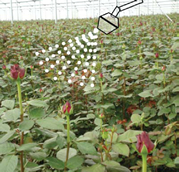 Downy mildew in roses is caused by an obligate biotrophic oomycete in the family peronosporacea namely Peronospora sparsa. As the scientific name indicates, the production of spores is sparse and therefore this disease is difficult to diagnose and control. It attacks all types of roses both in the greenhouse, nursery and the landscape from potted miniatures to landscape-size roses and even shrub roses. It causes destruction of leaves, stems, and flowers of the infected plant. The pathogen produces zoospores that have flagella they use to “swim” to ideal infection sites. That is why wet plant surfaces make the disease much more prevalent.
Downy mildew in roses is caused by an obligate biotrophic oomycete in the family peronosporacea namely Peronospora sparsa. As the scientific name indicates, the production of spores is sparse and therefore this disease is difficult to diagnose and control. It attacks all types of roses both in the greenhouse, nursery and the landscape from potted miniatures to landscape-size roses and even shrub roses. It causes destruction of leaves, stems, and flowers of the infected plant. The pathogen produces zoospores that have flagella they use to “swim” to ideal infection sites. That is why wet plant surfaces make the disease much more prevalent.
The fungus overwinters in or on plant parts as a vegetative mycelium or in fallen plant debris as hardy Oospores. The pathogen has short development cycles under optimum conditions, produces high quantities of spores and causes an irreversible damage to the crop.
